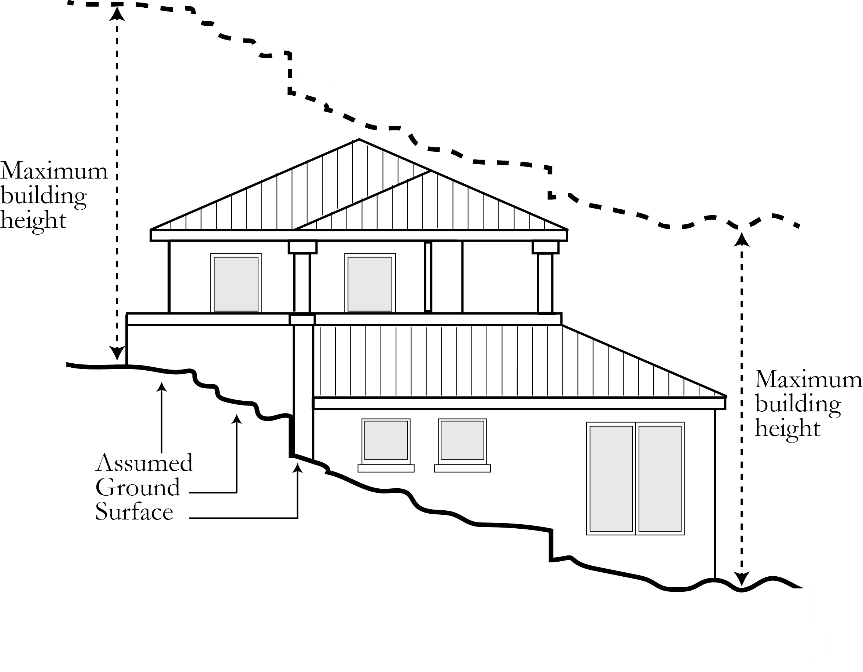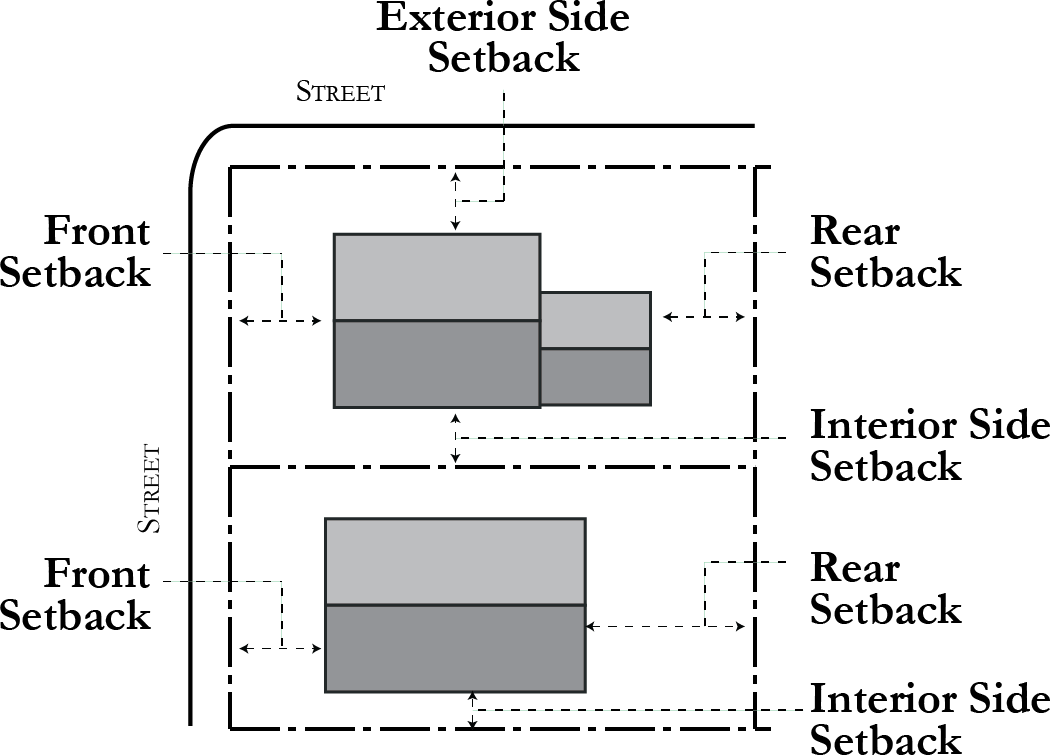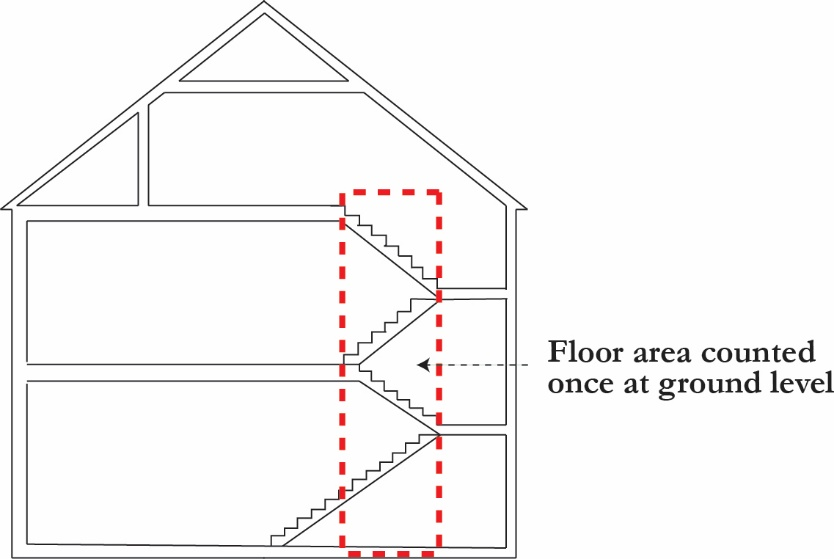Part 3. Citywide Standards
Chapter 17.48
HEIGHT, SETBACKS, AND FLOOR AREA Revised 4/23
Sections:
17.48.020 Height measurement and exceptions.
17.48.030 Setback measurement and exceptions. Revised 4/23
17.48.040 Floor area and floor area ratio. Revised 4/23
17.48.010 Purpose.
This chapter establishes rules for the measurement of height, setbacks, and floor area, and permitted exceptions to height and setback requirements. (Ord. 1043 § 2 (Att. 2), 2020)
17.48.020 Height measurement and exceptions.
A. Measurement of Height.
1. The height of a building is measured as the vertical distance from the assumed ground surface to the highest point of the building.
2. “Assumed ground surface” means a line on the exterior wall of a building that connects the points where the perimeter of the wall meets the finished grade. See Figure 17.48-1.
3. If grading or fill on a property within five years of an application increases the height of the assumed ground surface, height shall be measured using an estimation of the assumed ground surface as it existed prior to the grading or fill.
Figure 17.48-1: Measurement of Maximum Permitted Building Height
B. Height Exceptions. Buildings may exceed the maximum permitted height in the applicable zoning district as shown in Table 17.48-1. These exceptions may not be combined with any other height exceptions, including but not limited to allowances for additional height in the MU-V zone or for historic structures.
|
Structures Allowed Above Height Limit |
Maximum Coverage |
Maximum Projection Above Height Limit |
|---|---|---|
|
Nonhabitable decorative features including spires, belfries, cupolas, domes and other similar architectural elements |
10% of roof area |
3 ft. in the R-1 zoning district; 6 ft. elsewhere |
|
Skylights |
20% of roof area |
1 ft. |
|
Chimneys not over 6 feet in width |
10% of roof area |
3 ft. in R-1 zoning district; 6 ft. elsewhere |
|
Flagpoles not over 8 inches in diameter |
N/A |
3 ft. in R-1 zoning district; 6 ft. elsewhere |
|
Photovoltaic panels and thermal recovery systems |
No restriction; subject to California Building Code |
4 ft. |
|
Building-mounted telecommunications facilities |
See Chapter 17.104 |
|
(Ord. 1043 § 2 (Att. 2), 2020)
17.48.030 Setback measurement and exceptions. Revised 4/23
A. Setback Measurement. Setbacks from property lines shall be measured as the distance between the property line and the nearest point of the structure along a line at a right angle to the property line. See Figure 17.48-2. Required property line setback areas shall be free and clear of structures except as specified in subsections D and E of this section.
Figure 17.48-2: Setback Measurement
Note: See specific zoning district for required minimum setback.
B. Yards. When unique circumstances exist, the community development director has the authority to determine the lot configuration (i.e., designation of front, side, and rear property lines) based on existing conditions and function of the lot.
C. Projections over Property Lines. Structures may not extend beyond a property line or into the public right-of-way, except when allowed with an encroachment permit.
D. Projections into Required Setback. Features of the primary structure on a lot may project into required setback areas as shown in Table 17.48-2, subject to the requirements of the building code. See Chapter 17.52 (Accessory Structures and Uses) for setback requirements that apply to accessory structures. New projections into setbacks associated with ESHA are limited to the exceptions of Section 17.64.030(F) (Setback Exceptions on Developed Lots).
|
|
Maximum Projection into Setback |
Minimum Distances from Property Lines |
|||
|---|---|---|---|---|---|
|
Front |
Rear |
Interior Side |
Exterior Side |
||
|
Roof Projections |
|||||
|
Cornices, eaves, canopies, and similar roof projections |
4 ft. |
4 ft. |
2 ft. |
2 ft. |
All: 3 ft. |
|
Building Wall Projections |
|||||
|
Bay windows, sills, fireplaces, chimneys, and similar wall projections [1] |
2 ft. |
2 ft. |
2 ft. |
2 ft. |
All: 3 ft. |
|
Outdoor showers, including privacy screens |
0 ft. |
4 ft. |
4 ft. |
0 ft. |
Interior Side and Rear: 3 ft. |
|
Basement light wells |
3 ft. |
3 ft. |
3 ft. |
3 ft. |
All: 3 ft. |
|
5 ft. |
No max |
No max |
4 ft. |
Front: 10 ft. Exterior Side and Rear: 5 ft. Interior Side: 3 ft. |
|
|
Entry Features |
|||||
|
Stairways and fire escapes or similar features |
Not allowed |
4 ft. |
No max |
Not allowed |
Front: Not allowed Exterior Side: Not allowed Interior Side: 3 ft. Rear: 5 ft. |
|
At-grade flatwork such as concrete paving and patios |
No max |
No max |
No max |
No max |
All: No min |
|
Landing places, patios, and decks 18 inches or less above grade |
No max |
No max |
No max |
No max |
Front and Exterior Side: 5 ft. Interior Side and Rear: 3 ft. |
|
Open and unenclosed entry porches and decks 19 to 30 inches above grade |
4 ft. |
6 ft. |
1/2 of required setback |
4 ft. |
Front: 10 ft. Exterior Side and Rear: 5 ft. Interior Side: 3 ft. |
|
Covered entry porch and decks 19 to 30 inches above grade including roof and roof overhang |
5 ft. |
Not applicable |
Not applicable |
4 ft. |
Front: 10 ft. Exterior side: 5 ft. Interior Side and Rear: Not applicable |
|
Wheelchair ramps and similar features for the disabled |
No max |
No max |
No max |
No max |
All: No min |
Note:
[1] Projecting bay window may not exceed sixty percent of the width of the wall in which it is located.
E. Allowed Encroachments in Setback Areas and Yards. The following accessory structures and site improvements may project into required setback areas and yards as shown in Table 17.48-3, subject to the requirements of the building code. See Section 17.160.020(Y) for definition of “yards” as used in this section. New encroachments into setbacks and yards associated with specific coastal resource issues (e.g., ESHA setbacks, coastal hazard setbacks, etc.) are limited to the exceptions of Section 17.64.030(F) (Setback Exceptions on Developed Lots).
|
|
Minimum Distances from Property Lines |
||||
|---|---|---|---|---|---|
|
Front |
Rear |
Interior Side |
Exterior Side |
||
|
Decorative Site Features |
|||||
|
Up to two arbors up to 10 ft. in height with a minimum of 2 open sides utilized over a walkway |
No max |
No max |
No max |
No max |
All: No min |
|
Not allowed |
No max |
No max |
Not allowed |
Rear and Interior Side: No min Front and Exterior Side: Not allowed |
|
|
Planter boxes and masonry planters with a maximum height of 42 inches |
No max |
No max |
No max |
No max |
All: No min |
|
Decorative ornamental features up to a maximum height of 6 ft. which does not enclose the perimeter of the property |
No max |
No max |
No max |
No max |
All: No min |
|
Entertainment Features |
|||||
|
Hot tubs |
Not allowed |
No max |
Not allowed |
Not allowed |
Rear: 2 ft. All Other: Not allowed |
|
Pools |
Not allowed |
No max |
Not allowed |
Not allowed |
Rear: 5 ft. All Other: Not allowed |
|
Fire pits up to 30 inches in height |
No max |
No max |
No max |
No max |
All: 5 ft. |
|
Not allowed |
No max |
No max |
Not allowed |
Rear and Interior Side: 3 ft. Front and Exterior Side: Not allowed |
|
|
Not allowed |
No max |
Not allowed |
Not allowed |
Rear: 5 ft. |
|
|
Other Structures and Equipment |
|||||
|
Children’s play equipment, movable dog house, and similar movable objects |
No max |
No max |
No max |
No max |
All: No min |
|
Rain harvest tanks that do not exceed 8 ft. in height |
Not allowed |
No max |
No max |
No max |
Front: Not allowed All Other: No min |
|
Backup electricity generators |
Not allowed |
5 ft. |
Not allowed |
Not allowed |
Rear: No min |
|
Screened mechanical equipment including hot water heaters and air conditioning units |
Not allowed |
No max |
No max |
Not allowed |
Rear and Interior Side: 3 ft. Front and Exterior Side: Not allowed |
F. Encroachments in the Public Right-of-Way.
1. A privately installed structure may encroach into the public right-of-way only when the encroachment is authorized by the public works director or planning commission as provided in Chapter 12.56 (Privately Installed Improvements on Public Property or Easements).
2. In the coastal zone, a privately installed structure encroaching into the public right-of-way may require a coastal development permit (CDP) as specified by Chapter 17.44 (Coastal Overlay Zone) and the findings for approval of a CDP as specified in Section 17.44.130 (Findings for approval), with the additional findings that the encroachment does not restrict lateral and vertical public coastal access, does not obstruct public coastal views, and does not impact ESHA, as identified in the local coastal program. To the extent the encroachment is allowed, all encroachments shall be revocable.
G. Building Separation. Separation between two or more buildings shall be as required by the California Building Code. This requirement applies to buildings on a single lot and buildings on adjacent lots.
H. Basements. Basements are subject to the same property line setback requirements as the ground floor. (Ord. 1057 § 2 (Att. 1), 2022; Ord. 1043 § 2 (Att. 2), 2020)
17.48.040 Floor area and floor area ratio. Revised 4/23
A. Floor Area Defined. “Floor area” means the sum of the horizontal areas of all floors of an enclosed structure, measured from the outside perimeter of the exterior walls.
B. Floor Area Calculation.
1. Floor area includes all interior area below a roof and within:
a. The outer surface of the exterior walls; or
b. The centerlines of party walls separating buildings or portions thereof; or
c. All area within the roof line of a carport.
2. Floor area includes the entire area in all enclosed structures without deduction for features such as interior walls or storage areas.
3. In the case of a multistory building with covered or enclosed stairways, stairwells or elevator shafts, the horizontal area of such features is counted only once at the floor level of their greatest area of horizontal extent. See Figure 17.48-3.
Figure 17.48-3: FAR Measurement for Stairways
4. Interior area of a building with a floor-to-ceiling height of greater than sixteen feet is counted twice in the floor area calculation.
5. The following features are included in the floor area calculation:
a. All upper-floor area greater than four feet in height, measured between the bottom of the upper floor and the top of the ceiling.
b. All accessory structures other than a single building one hundred twenty square feet or less, ten feet or less in height, and without plumbing fixtures.
c. Carports.
d. Upper-floor decks in excess of one hundred fifty square feet.
6. For all uses, the following features are excluded from the floor area calculation:
a. Covered or uncovered first-story decks and patios.
b. Pergolas, porte-cocheres not more than ten feet in height, and similar outdoor space which is open on at least three sides, not including carports.
c. Upper-floor decks one hundred fifty square feet or less.
d. Bay windows, chimneys, and other similar wall projections.
e. Up to two hundred fifty square feet of an enclosed garage on a lot two thousand five hundred eighty-six square feet or less.
f. On a lot between two thousand five hundred eighty-six and three thousand eighteen square feet with an enclosed garage, up to the difference between the maximum allowed floor area and one thousand seven hundred fifty square feet.
g. Underground parking garages not visible from a public street.
h. Basements when all walls are below grade and not visible. Basements are included in calculations of required on-site parking to serve the use.
7. For nonresidential uses, the following features are excluded from the floor area calculation:
a. Outdoor improvements such as patios, decks, courtyards, outdoor dining areas, and other areas used by customers and employees. These features are included in calculations of required on-site parking to serve the use.
b. Arcades, porticoes, and similar open areas that are located at or near street level and are accessible to the general public but are not designed or used as sales, display, storage, service, or production areas.
c. Quasi-public seating areas located in a privately owned shopping center which are open to all of the patrons of all of the businesses of the shopping center and which consist of a seating area or similar area where there are tables, chairs, benches or landscaping or other similar amenities.
C. Floor Area Ratio.
1. Floor area ratio (FAR) is calculated by dividing the total floor area of all buildings on a site as defined in subsection B of this section (Floor Area Calculation) by the net parcel area.
2. Net parcel area excludes: (a) any recorded easements to allow others to use the surface of the property for access to an adjacent property or other similar use, and (b) any area under the high water mark that extends into a waterway. (Ord. 1057 § 2 (Att. 1), 2022; Ord. 1043 § 2 (Att. 2), 2020)


